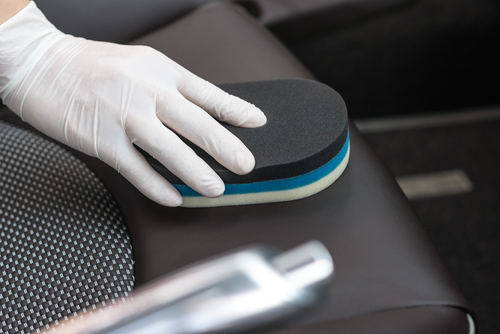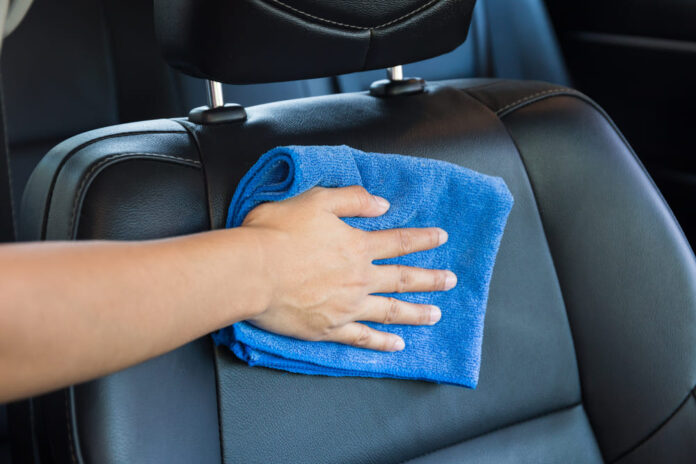A well-kept car is an absolute eye catcher. And what’s more: regular maintenance contributes to value retention. This applies not in the least to the passenger cabin and the car seats, subject to daily use. In this guideline you will learn more about the proper way to clean car seats and which products ensure a clean result.
Cleaning the car seats – DIY or ask the professional?
Basically, cleaning the car seats is a DIY job. The specialised dealer has the right cleaners for fabric, leather and other materials available, ensuring the best result when used the right way. Visiting a garage for professional cleaning of your car seats is recommended for two reasons. Firstly, many car owners want to save themselves the trouble of cleaning and are happy to leave it to a service provider. Secondly, the nature of the soiling can cause uncertainty or exceed your skills. Simple food & drink stains are easy to remove. However, if grease, oil or chemicals have penetrated your car seats, traditional cleaners are often insufficient. In this case, the assistance of a professional is recommended as not to make the stain worse. Several garages are happy to have a look at your car seats and recommend specific products if you aren’t able to assess the nature of the contamination.
Secondly, the nature of the soiling can cause uncertainty or exceed your skills. Simple food & drink stains are easy to remove. However, if grease, oil or chemicals have penetrated your car seats, traditional cleaners are often insufficient. In this case, the assistance of a professional is recommended as not to make the stain worse. Several garages are happy to have a look at your car seats and recommend specific products if you aren’t able to assess the nature of the contamination.
Proper removal of different stains
For your car seats applies the same as for your sofa: depending on material and stain, cleaning is either very simple or very difficult.
 Everyday stains on fabric seats can be removed very simply. Often, the use of household products like shaving foam or a universal cleaner from the supermarket will do. Use a household brush for rubbing the detergent into the fabric in order to soak dried stains.
Everyday stains on fabric seats can be removed very simply. Often, the use of household products like shaving foam or a universal cleaner from the supermarket will do. Use a household brush for rubbing the detergent into the fabric in order to soak dried stains.
Do not apply excessive force to prevent from rubbing trough the fabric causing it to become thinner.
 Cleaning car leather seats is rather more complicated. You can’t avoid special cleaning agents and should handle carefully. Applying to much water can cause permanent stains. The nature of the stain is a more important factor for leather than for fabric. Quick removal of the soiling ensures the best chances of success. As soon as oil, grease or wine stains have dried, very often totally removing the stain becomes impossible.
Cleaning car leather seats is rather more complicated. You can’t avoid special cleaning agents and should handle carefully. Applying to much water can cause permanent stains. The nature of the stain is a more important factor for leather than for fabric. Quick removal of the soiling ensures the best chances of success. As soon as oil, grease or wine stains have dried, very often totally removing the stain becomes impossible.
 The most important info on cleaning car seats in an overview
The most important info on cleaning car seats in an overview
1. What do you need?
| – Spray foam/shaving foam |
| – Universal detergent or special detergent |
| – Bucket and cloth, e.g. cotton |
| – Brushes, e.g. for fabric or buckskin |
| – Vacuum cleaner |
2. What products are available?
| – Household products (vinegar, washing powder, shaving foam) |
| – Detergents (universal or specifically suitable for car seats) |
| – Leather care product (e.g. with UV-protection, colourless shoe cream) |
| – Special products (e.g. cleaning clay) |
3. How expensive will it be?
| – Household products (a few £) |
| – Special cleaners: depending on quantity £3 – £8 |
| – Special leather care products: Often £8 and more |
4. What are the advantages?
| – Quick and simple treatment |
| – The possibility of removing stains yourself |
| – Manageable amount of work |
| – Valuable contribution to value retention of the car |
5. What are the disadvantages?
| – Regular repetition necessary |
| – Risk of choosing the wrong cleaner |
| – Additional stains due to too much water |
 This is the right way to clean fabric upholstery
This is the right way to clean fabric upholstery
If you want to clean fabric upholstery, we recommend as a first step a complete basic cleaning of your car interior. Thoroughly vacuum-clean the entire car to remove crumbs and particles from the crevices between the cushions. Simultaneous brushing helps removing hairs etc. from the seat surface.
 Inspect the condition of the seats. If stains can clearly be identified as food, drink, etc., we recommend applying household products such as spray cleaner or e.g. shaving foam. This way the fabric pores are well foamed which often helps against persistent or dried stains. Shaving foam is relatively uncomplicated. Spray cleaners from a bottle might be only suitable for specific fabric and stains. Please inform yourself about this in advance and try the cleaner on an inconspicuous spot. Spray cleaners are no remedy for persistent stains such as oil or blood.
Inspect the condition of the seats. If stains can clearly be identified as food, drink, etc., we recommend applying household products such as spray cleaner or e.g. shaving foam. This way the fabric pores are well foamed which often helps against persistent or dried stains. Shaving foam is relatively uncomplicated. Spray cleaners from a bottle might be only suitable for specific fabric and stains. Please inform yourself about this in advance and try the cleaner on an inconspicuous spot. Spray cleaners are no remedy for persistent stains such as oil or blood.
Now rub the fabric with a damp cloth (definitely not soaking wet) and a traditional cleaning detergent evenly. If the stains are not too persistent, general cleaner or washing powder is sufficient. In case of persistent and complicated stains, the purchase of a special cleaner is the best choice. Allow the seats to dry after treatment before you start the after-treatment or vacuum cleaning.
 What you should consider about leather car seats
What you should consider about leather car seats
Cleaning leatherette and smooth leather is relatively easy. Especially if you maintain your car well, using a sealing leather care product, most stains will not penetrate the material. Velvet and buckskin are a bigger challenge as they immediately absorb stains and don’t allow sealing.
 Leather car seats maintenance requires a cleaning clay. The careful cleaning with a solution of a mild detergent is an adequate alternative for soaking the worst dirt.
Leather car seats maintenance requires a cleaning clay. The careful cleaning with a solution of a mild detergent is an adequate alternative for soaking the worst dirt.
Never apply too much water as this causes permanent stains. If you work with a spray cleaner, be certain to keep it at distance from the material. Very important is regularly applying special care products as an after-treatment. These are particularly recommended for smooth leather. Depending on the type of leather even shoe cream can be used for sealing, which must be allowed to properly be absorbed to prevent it from staining passenger’s clothing.
 Further tips for value maintenance of your car seats
Further tips for value maintenance of your car seats
– For many stains in the car, quick action is the best step to protect your car seats against permanent damage and a spoiled appearance.
Therefore always travel with cleaning cloth. Cotton cloth offers valuable assistance with many stains.
– If you want to run no risk at all for the value retention of your car, protective sheets are an ideal protection for the surface of your car seats.
Every manufacturer offers a tailored solution for all model series. Many of these protective covers can be machine-washed or completely replaced, permanently keeping the car seat in impeccable condition.
Foto: Gargantiopa, Peter Gudella, Bhakpong, Himchenko.E / shutterstock.com













